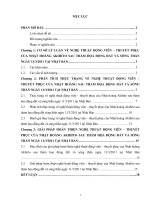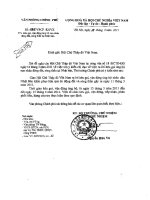Tài liệu động đất sóng thần
Bạn đang xem bản rút gọn của tài liệu. Xem và tải ngay bản đầy đủ của tài liệu tại đây (553.75 KB, 30 trang )
Overview on Tsunami Risk Evaluation
and NPP Project in Vietnam
Le Dai Dien
Nuclear safety Center
Institute for Nuclear Science and Technology (INST)
179-Hoang Quoc Viet, Caugiay-Hanoi, Vietnam
Email:
Presented at the 1st Kashiwazaki International Symposium on Seismic Safety of Nuclear
Installations , 24 - 26 November 2010, NIIT, Kashiwazaki, Niigata, Japan
CONTENT
I. The 1st NPP project : Background
II. Tsunami Risk Evaluation: Some remarkable notices
III. External hazards for NPP in Vietnam
IV. Conclusions and suggestions
The presentation is based on:
- The PFS for NinhThuan NPP Project by EVN
- Tsunami Investigations by:
+ Marine Management Institute, Vietnam Administration for Sea and Islands
+ Institute of Geophysics, Vietnam Academy of Science and Technology
+ and others.
I. The 1st NPP project : Background
1. Long-term strategy for Peaceful Utilization of Atomic
Energy up to 2020 is approved by the government (Jan
2006).
2. Prime Minister approved the Master Plan for
Implementation of the Long-term Strategy (June 2007).
3. Atomic law is approved (Jan 2008)
4. National Assembly approved for investment project for
NinhThuan NPPs (25 nov 2009).
VN Government has made a strong commitment on development
of nuclear power with the goal for building the first NPP in 2014
and operation by the year 2020.
I. The 1st NPP project : Background
Ninh Thuan I NPP Project
Site : Phuoc Dinh
Capacity : 4 units x 1000 MW
Topographic Conditions for Plant platform are defined
based on the requirements:
The ability to avoid flooding threat;
Surface water is well drained;
The Cooling water system is operated economically and
realiable;
Minimize volume and cost for platform leveling
I. The 1st NPP project : Background
Ninh Thuan I NPP Project
I. The 1st NPP project : Background
Ninh Thuan I NPP Project
I. The 1st NPP project : Background
Ninh Thuan I NPP Project
II. Tsunami Risk Evaluation: Some remarkable notices
Historic documents about tsunami in Vietnam
+ The first event is abnormal high waves
attacking Tra Co coast in 1978 (waves with
height of 2 m to 3 m)
+ The beginning of the 20th century. waves
with the height of more than 3m attacked the
coast of Dien Chau.
+ 1923 - related to the eruption of Hon Tro
Volcano, ( caused an earthquake with the
magnitude of 6.1 Richter). strong tsunami
attacked Mui Ne and NhaTrang
However, the recorded data were not reliable enough, and
detailed studies are needed.
II. Tsunami Risk Evaluation: Some remarkable notices
During November - Dec 2005 and March – April 2006
+ Investigated excavation sites at six points:
Cua Lo, Song Cau, Nha Trang, Phan Rang, Phan Thiet
+ Samples at different sediment layers for the analysis.
+ Found that a huge tsunami with the maximum height of 18m
attacked a coast of more than 1000 km length at Central
Vietnam
With investigation results, there are possibilities of the events
of tsunami attacking Vietnamese coast.
II. Tsunami Risk Evaluation: Some remarkable notices
Institute of Global Physics
(Tsunami Warning and Earthquake Information Centre)
+ Among 25 scripts for earthquakes and tsunamis in Vietnam,
scenario 4 (earthquake of 8.6 Richter scale at Manila fault) is
chosen as the standard to make economic and social plans for
the coastal region and to design the evacuation plan.
+ 24 earthquake observation centres nationwide
II. Tsunami Risk Evaluation: Some remarkable notices
Tsunamigenic earthquake scenarios
There are four zones of
earthquake sources in the South
China Sea:
+ Manila Trench,
+ Ryukyu Trench (Nansei-Shoto
Trench)
+ south of Hainan Island.
+ Central South China Sea
The study on the tsunami risk in Vietnam is mainly based
on the earthquake data in the South China Sea, especially
that from the Manila Trench.
II. Tsunami Risk Evaluation: Some remarkable notices
Tsunami earthquake progression is affected by many factors:
+ Common tsunami caused by deep seafloor deformations:
movements and shifts. Source orientation is one of the factors which
affected arrival time and amplitude of tsunami
+ Tsunami propagation from the generation site to the coastline
which is affected by ocean bathymetry. The velocity of tsunami in
deep ocean is proportional to square root of water depth, so that
tsunami reaches the shallower coastal area it begins to slow in speed
and rise in height.
+ The waves reflected from various coastlines (ex. the resonance
of bay or harbor).
=> The collected data has not been reliable enough, and
detailed studies are necessary.
II. Tsunami Risk Evaluation: Some remarkable notices
Scenario checking results
Earthquake with magnitude greater than 8 can generate
significant tsunami at Vietnamese coast.
• The risk of tsunami at Vietnam coast is small;
• Results of computation show that the most dangerous
earthquakes are that with magnitude of greater than 8 in
the Manila Trench;
• The possible strongest earthquake in the Manila Trench
have the magnitude of 8.5. Thus, tsunami risk at Vietnam
coast exists;
• An earthquake with the magnitude of 9 in Ryukyu Trench
and earthquake with magnitude of 7.5 at south Hainan
island may cause significant tsunami at Vietnam coast;
II. Tsunami Risk Evaluation: Some remarkable notices
Estimated tsunami heights based on earthquakes
at Manila fault
EQ
magnitude
Hoang
Sa
archipel
ago
Truong
Sa
archipe
lago
From
Thua
Thien –
Hue to
Da Nang
From
Quang
Nam to
Quang
Ngai
From
Binh
Dinh to
Ninh
Thuan
From Binh
Thuan to
Ba Ria –
Vung Tau
8
2.5m
1m
< 1m
1-2m
1m
< 1m
8.4
4m
2m
> 1m
2-4m
1.5-2m
1m
8.6
8-9m
4-6m
3-5m
7-10m
3-5m
1.5m
(Richter
scale)
Vu Thanh Ca and Nguyen Dinh Xuyen-Tsunami risk along Vietnamese coast
Journal of Water Resources and Environmental Engineering, No. 23, November 2008
II. Tsunami Risk Evaluation: Some remarkable notices
EQ of magnitude 9 occurs at the
Manila Trench.
+ The area of tsunami height of
more than 1m streches from Hai
Phong in the North to Ca Mau in
the South.
+ The coast with tsunami height
of more than 2m streches from
Quang Tri to Phan Thiet.
+ Especially, at Quang Ngai, the
maximum tsunami height is more
than 10m.
“Tsunami hazard mapping project for Vietnamese coasts”,
funded by the Ministry of Natural Resources and Environment of Vietnam.
Vu Thanh Ca and Nguyen Dinh Xuyen-Tsunami risk along Vietnamese coast
Journal of Water Resources and Environmental Engineering, No. 23, November 2008
II. Tsunami Risk Evaluation: Some remarkable notices
Assessment of Bathymetry Effects on Tsunami Propagation in Viet Nam
by Nguyen Anh Duong, Fumiaki Kimata, Irwan Meilano
+ Research Center for Seismology, Volcanology and Disaster Mitigation Nagoya University - Japan.
Fronts A and B pointing
towards Vietnam coastal
area caused by near shore
bathymetry.
The red star shows the
Feb. 14th 1934 EQ
with magnitude of 7.5 on
northwest coast of Luzon
island which generated
tsunami.
II. Tsunami Risk Evaluation: Some remarkable notices
Scenario 1: Fault
source is moved
southward along
Manila Trench next to
the real EQ with M7.5
in 1934.
Tsunami travel time map counted from M7.5 Manila Trench
source in 1934. Contour timelines – 15’ from the origin time
II. Tsunami Risk Evaluation: Some remarkable notices
Distribution of tsunami height caused by fault source
moved southward along Manila Trench next to the real EQ
(1934 – M7.5)
II. Tsunami Risk Evaluation: Some remarkable notices
The project “Tsunami Risk Assessment and mitigation in S&SE Asia
– Phase 2” : Evaluation tsunami hazard in Vietnam and Gulf of
Thailand by NGI (The Norwegian Geotechnical Institute) 2009
30 minutes
1 hour
2 hours
Snapshots of the simulated tsunami generated by the Mw8.2 Manila
Trench scenario EQ.
Conservative case: EQ with magnitude 8.2 in the northern
part of the Manila Trench is selected.
II. Tsunami Risk Evaluation: Some remarkable notices
Project: Tsunami Hazards, Risk and Preparedness for
Vietnam
With support from New Zealand NZAID Asia Development
Assistance Facility (2007 – 2009)
Design of seismic and tsunami monitoring system.
III. External hazards for NinhThuan 1 NPP
Safety against external hazards to nuclear
installations:
+ Earthquakes,
+ Flooding,
+ Tsunami and
+ Meteorological hazards (typhoon, cyclone…)
III. External hazards for NinhThuan 1 NPP
Seismic issues
Map of active faults and
distribution of earthquake
epicenters in Vietnam and
surrounding countries for the
period from 1067 to 2002.
Green circles indicate
historical earthquakes over the
period from1067 to 1900
Huang, B.-S., et al. Portable broadband
seismic network in Vietnam for investigating
tectonic deformation, the Earth’s interior, and
early-warning systems for earthquakes and
tsunamis. Journal of Asian Earth Sciences
(2009)
III. External hazards for NinhThuan 1 NPP
Seismic issues
Research project of the Vietnam Institute of Geophysics
(VIG): “Research and Forecasting Earthquakes and Ground
Movements in Vietnam” : 114 - 2003 1,645 recorded EQ with
magnitude (M) of 3 or > 3 on Richter scale.
The Ministry of Construction (MOC) has recently issued
the new VN EQ loading standard TCXDVN 375:2006.
It has been found that the lack of historical data and lack of
information on the local site soil conditions has created
difficulties in using the code for design or assessment of
structures in Vietnam,
A review of the Current Vietnamese Earthquake Design Code-T.D. Ngo, M.D.
Nguyen,, D.B. Nguyen. Earthquake Engineering in the low and moderate seismic
regions of Southeast Asia and Australia (2008)
III. External hazards for NinhThuan 1 NPP
Seismic issues
Southern Vietnam was always considered as a region
with low seismicity, compared to the North.
On 5 August 2005, an EQ occurred offshore of Vung
Tau city with M = 4.6
On 8 November 2006: EQ with Magnitude 5.5 (HCM city)
with original center some 100 km off the coast of Vung
Tau. This EQ was considered as the strongest EQ in the
South of Vietnam
III. External hazards for NinhThuan 1 NPP
Hydrology and tide regimes (Ninh Thuan 1 NPP site):
(Data from Center for Meteorology and Climatology-Institute of Meteorology and
Hydrology)
+) Tide level at Vĩnh Trường village (by National Coordinate Sys.
VN2000)
- Average sea water level : -0,26m
- Maximum of highest rise of tide : Pmax =1,18m
- Minimum of lowest rise of tide : -1,65m
+) Highest wave (east direction) : Hsmax=6,21m
+) Water level rised by typhoon : Hd =0,89m
+) Historical flooding trace by Cái Phan Rang
river : 2,74 m.









